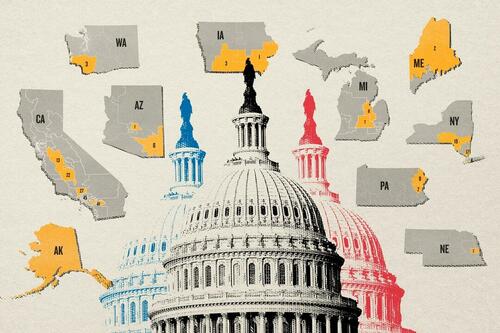UK releases more prisoners early to make room for anti-immigration protesters
“Prison has a place, but we must also improve rehabilitation.”
Over 700,000 Haitians displaced as gang violence worsens: UN
“The security situation remains extremely fragile, with renewed peaks of acute violence.”
BREAKING: North Koreans enter combat zone in Ukraine to help Russia’s fight, Kyiv says
“The first units of military from North Korea … have already arrived in the combat zone of the Russian-Ukrainian war – in particular, on October 23, 2024 their appearance is recorded in the Kursk region of Russia.”
20 Races That Could Determine Control Of The House
20 Races That Could Determine Control Of The House
Authored by Joseph Lord, Stacy Robinson via The Epoch Times (emphasis ours),
While most national attention is on the top-of-the-ticket race between former President Donald Trump and Vice President Kamala Harris, control of Congress will be equally consequential.
Republicans currently hold a narrow majority of eight seats in the House, meaning they can only spare three defections on big votes. Democrats, with four independents, hold a one-seat majority in the Senate and the tie-breaking vote.
While Republicans are favored to reclaim the Senate, the fate of the House remains more uncertain.
Whoever is president will need full control of Congress to get much done during their term.
House Republicans seek to grow their thin, ideologically divided majority and Speaker Mike Johnson (R-La.) has indicated his intention to seek reelection as speaker.
Democrats are seeking to reclaim the majority, which they controlled from 2019 to 2023, and to place House Minority Leader Hakeem Jeffries (D-N.Y.) in the speaker’s chair.
Of the 435 House races, there are around two dozen that are expected to ultimately determine control of the House of Representatives in the 119th Congress.
Each race listed here is rated by the Cook Political Report as a “toss-up,” making these races among the hardest to predict.
New York
Republican control of the House is largely due to the party’s victories in New York in 2022, when several Republicans won districts that had voted for candidate Joe Biden just two years prior.
While the expected red wave didn’t fully materialize nationwide, there was a notable Republican surge in New York.

The most surprising win was Rep. Mike Lawler’s (R-N.Y.) defeat of incumbent Rep. Patrick Maloney (D-N.Y.), the then-chair of the Democrats’ House campaign arm.
Lawler, whose district lies just north of New York City, won by a 0.6 percent margin in an upset that shocked even bullish Republicans.
This year, Lawler is leading his Democratic opponent, Mondaire Jones, by just one point, an Oct. 3 Emerson College poll shows.
Meanwhile, Reps. Marc Molinaro (R-N.Y.) and Anthony D’Esposito (R-N.Y.)—both of whom represent Biden-voting districts—are also seeking to hold onto their closely contested seats.
Molinaro won by just around a 1.6 percent margin, while D’Esposito enjoyed a more comfortable 3.6 percent.
Current polling results for both candidates lie in the margin of error: the most recent polling of each race has each trailing the Democrat candidate by three points.
However, other polling showed D’Esposito in a stronger position, leading earlier polling by six points.
Although the results in 2022 suggested New York could be trending Republican, it remains to be seen if the party can maintain that momentum in 2024.

California
Equally important to Republicans’ narrow reclamation of the House in 2022 was California, where Republicans also made gains in districts outside of the blue strongholds that dot the state’s coast.
Now, several GOP incumbents face tight reelection battles to hold on to those districts.
Five California Republicans—Reps. John Duarte, David Valadao, Mike Garcia, Ken Calvert, and Michelle Steel—are in extremely close races. All but one of these districts voted for Biden in 2020, highlighting their competitive nature.
Duarte narrowly won his central California seat in 2022 with 50.2 percent to his Democratic opponent’s 49.8 percent, a difference of just 0.4 percent. Polling this cycle shows them neck and neck, with the latest poll giving the Democrat a 1-point edge.
Valadao, who won by a 3-point margin in 2022, faces a much closer race this time, with recent polling showing the race tied.
Garcia won by 6.4 points last cycle, but polling shows him trailing by two points in his northern Los Angeles district.
Calvert and Steel both won by more than four points in 2022. This time around, Steel is again ahead by four points, while Calvert is tied with his Democratic opponent.
Holding these seats is vital for the Republicans to maintain or grow their House majority in 2024.

Rust Belt
While Republicans may be on the defensive in blue strongholds like New York and California, Democrats are similarly on the defensive in two of this election’s most crucial states: Michigan and Pennsylvania.
At the presidential level, these two states are expected to play a huge role in determining the ultimate victor in the election.
These states, along with Wisconsin, were once known as the “Blue Wall” for their long streak of backing Democrats and formed the backbone of their electoral strategy.
Since Trump, however, Republicans have seen a resurgence in the region as its many white working-class voters move over to the GOP camp.
In both 2016 and 2020, these three states, particularly Wisconsin and Pennsylvania, were decided by razor-thin margins.
In Michigan—generally considered the most liberal of the three—Republicans are vying to flip control of two open seats abandoned by Reps. Elissa Slotkin (D-Mich.) and Dan Kildee (D-Mich.).
While Slotkin won by 5 percent in 2022 and Kildee won by 10 percent, polling shows that the two races are on track to be far more competitive this time.
Republicans lead by four points in Slotkin’s 7th Congressional District, according to polling from early October, and by a single point margin in Kildee’s 8th Congressional District, according to polling from the beginning of August.

Picking up one or both of these seats would represent a major gain for Republicans, who stand to benefit from the loss of the two Democratic incumbents.
Over in Pennsylvania, considered the most consequential swing state this cycle, Reps. Susan Wild (D-Pa.) and Matt Cartwright (D-Pa.) are seeking to hold their seats.

Wild, representing Allentown and its environs, won by a narrow two-point margin in 2022.
Recent polling suggests she’s on track to hold the seat, with the most recent poll ending Oct. 3 finding a six-point lead for Wild.
Cartwright, meanwhile, won with 51 percent to Republicans’ 48 percent in 2022. Polling this cycle shows a 3.1 percent lead for Cartwright, though low sample sizes in these polls mean the race is still within the margin of error.
Arizona
Arizona, another battleground state, is home to some of the most contested races in the 2024 cycle.
Two Republican incumbents, Reps. David Schweikert (R-Ariz.) and Juan Ciscomani (R-Ariz.), face tough reelections in districts that narrowly voted for Biden in 2020.

Schweikert won his 1st Congressional District seat in 2022 by less than 1 percent of the vote after the district backed Biden by 1.5 percent in 2020.
Polling shows a slight edge for Democrats, who led by 1 percent in a poll that concluded on Aug. 13, though two earlier polls showed a tie. More recent polling isn’t available.
Ciscomani won his 6th district seat by similarly thin margins in 2022, securing 50 percent to Democrats’ 49 percent. Like Schweikert, his district backed Biden in 2020 by around 1.1 percent.
There’s no recent polling available for Ciscomani’s race.
Retaining the districts is crucial for Republicans to grow their House majority, with both expected to be decided by razor-thin margins in 2024.
Read the rest here…
Tyler Durden
Thu, 10/24/2024 – 06:30
FEMA’s Real Purpose: Suppressing Americans And Preventing Civilian Organization
FEMA’s Real Purpose: Suppressing Americans And Preventing Civilian Organization
Authored by Brandon Smith via Alt-Market.us,
The Federal Emergency Management Agency (FEMA) was founded on April 1st, 1979 under the Jimmy Carter Administration during the height of a nearly decade long stagflationary crisis and the Iranian oil crisis. Under Executive Order 12127, its stated goal was to centralize all disaster related efforts under a single top-down entity. Specifically, FEMA ended the more localized Civil Defense Agency, which was focused on community based emergency response, and it federalized all disaster coordination under a single top-down system controlled by the Oval Office.
FEMA was eventually placed under the purview of the Department of Homeland Security, creating even more centralization. The reason for FEMA according to the government is to aid Americans during and after a national level disaster event; anything from earthquakes to hurricanes to terrorist attacks.
That said, it should also be noted that FEMA was officially created on April Fool’s Day.
The true purpose of FEMA has long been obscured but some disturbing truths have been exposed in the past. The declassification of a program called Rex 84 (tied to Operation Garden Plot) revealed that FEMA was working directly with the Department of Defense on a hypothetical strategy to round up and detain large numbers of civilians considered a “threat to national security.” In other words, FEMA was to act as a tool for helping suppress civil disturbances, it was not necessarily designed to help Americans in times of need.
This was likely always the intent behind the founding of FEMA, but George H.W. Bush and Oliver North are cited as the men that truly militarized FEMA in the early 1980s. The goal to establish a mechanism for controlling domestic political dissent and suspending constitutional freedoms was exposed not long after FEMA’s founding. Oliver North was visibly enraged when the subject was broached in a congressional hearing during the Iran/Contra scandal.
It should be mentioned that the REX 84 documents do not list FEMA as a primary agency in control of civil disturbance response. This is where the accusations of “conspiracy theory” usually come from – FEMA is not the end-all-be-all agency in charge of locking down American rebellion. In fact, FEMA’s role is strangely ambiguous and is not clearly defined. All that is known is that they are indeed an element of Operation Garden Plot and have participated in REX exercises.
There’s no denying that the secrecy around civil disturbance programs is pernicious and suggests that there is far more going on than our own government cares to admit. To uncover FEMA’s real intent all we have to do is examine how they behave.
The recent Hurricane Helene disaster and FEMA’s handling of the response across the East Coast echos the agency’s crimes after Hurricane Katrina in New Orleans in 2005. Their emergency “aid” is used as a cloak to hide efforts to actually STOP communities from helping each other and preventing outside civilian funded supplies from reaching affected residents in need.
Desperate residents during Katrina were treated like prisoners rather than citizens, gun confiscation took place in many areas and some people were shot for trying to leave locked down neighborhoods. (As a side note – this is why you should NEVER let anyone confiscate your firearms, especially if those people are sent by the government)
CNN reported in 2008 that FEMA confiscated at least $85 million in donated goods and prevented them from reaching Katrina disaster victims. This included clothing, bedding, food and medical supplies. They stored these materials for years and then GAVE AWAY the supplies long after Katrina was over. FEMA claimed the supplies were “in excess to their needs.” This report and all related articles now seem to be missing from CNN’s archives.
We just witnessed a repeat of this behavior from FEMA and the affiliated agencies within their oversight. We saw local EMS being advised to prevent civilians from helping their communities. Supplies were once agaun being blocked, people with drones were being told not to help find survivors, people with helicopters are were threatened for helping save survivors and little aid reached Helene victims for weeks. Elon Musk’s Starlink was even been prevented from providing satellite internet services to affected regions until the story went national and the Department of Transportation was forced to address the problem.
It’s Katrina all over again, and FEMA always seems to have excuses.
But why? You would think that with an election only weeks away Biden and Harris would be jumping at the chance to look competent and useful. Instead, they did nothing other that offer a $750 relief check to survivors (which might help people survive for a week) and then referred people to federal programs which take many months to benefit from.
I argue that this is all deliberate. FEMA and the federal government at large are still using Operation Garden Plot-like protocols with two goals in mind…
First, they are trying to acclimate the populace to the idea that civilians can’t help themselves and that they should do nothing. They do this by constantly interfering with civilian efforts and disrupting donations. If civilians are working on their own to save US communities from calamity then they might one day realize they don’t need the Federal Government for anything. The establishment NEEDS people to believe that they can’t survive without government aid and protection. Luckily, at least in the aftermath of Helene, it seems that many communities are working on their own to fix the situation.
If civilians start doing things for themselves, the establishment machine becomes obsolete.
Second, I suspect FEMA is testing the waters to see how much they can get away with. Katrina was a clear beta-test for martial law disguised as an emergency response. Katrina was Garden Plot and Rex-84 realized. They want to see what Americans will put up with. Helene is yet another opportunity for these agencies to apply overt control and see if Americans will conform or rebel.
If FEMA is truly sincere in their efforts to help Americans they certainly don’t act like it. The criticism surrounding Helene is ramping up and FEMA’s indignant attitude towards their own failures in unacceptable. They should be punished for failing in their duties. That is assuming they are actually failing.
Maybe they consider the tragedy of government inaction surrounding Helene a success? The underlying point is, when disaster comes your way, it’s not enough to merely count FEMA out as a source of aid. That’s obvious. But you will also have to consider the possibility that the agency will work directly against you and your neighbors should you try to help yourselves.
* * *
If you would like to support the work that Alt-Market does while also receiving content on advanced tactics for defeating the globalist agenda, subscribe to our exclusive newsletter The Wild Bunch Dispatch. Learn more about it HERE.
Views expressed in this article are opinions of the author and do not necessarily reflect the views of ZeroHedge.
Tyler Durden
Wed, 10/23/2024 – 23:25
Apple “Might Wind Down” Vision Pro Production Next Month Due To “Weak Demand”
Apple “Might Wind Down” Vision Pro Production Next Month Due To “Weak Demand”
A new report from The Information suggests Apple might suspend production of its Vision Pro mixed-reality headset as early as next month due to very weak demand. Some Asian suppliers have already reduced or stopped producing headset components since the summer. Additionally, the development of the next Vision Pro model has been delayed, while a more affordable headset is slated for the retail market by the end of 2025.
The first version has met weak demand, a result of its high price and the lack of apps available on it. Employees at three Vision Pro suppliers that supply a range of electrical and mechanical components told The Information they have so far built enough components for between 500,000 and 600,000 headsets.
One of the employees said their factory suspended production of Vision Pro components in May based on Apple’s weak forecasts, and their warehouse remains filled with tens of thousands of undelivered parts.
. . .
In recent weeks, Apple has told Luxshare, which is responsible for the Vision Pro’s final assembly, that it might need to wind down its manufacturing in November, according to an employee at the Chinese manufacturer. Luxshare is making around 1,000 Vision Pro units a day, down from a peak of around 2,000 units a day, the employee said. It has assembled a total of between 500,000 and 600,000 headsets since production began last year ahead of its February release in the U.S., the employee said.
Apple’s move into the mixed-reality headset market with its $3,500 Vision Pro seems poorly timed, given the financial strain on many low- to mid-tier consumers. High inflation and elevated interest rates, primarily attributed to failed Bidenomics, have left millions of cash-strapped Americans in financial misery as they struggle to cover basic expenses like rent, groceries, car payments, insurance, and phone bills.
The Vision Pro flop is nothing new to readers. We commented on a WSJ note earlier this month that showed the dismal demand for the headset means no ‘killer app’ anytime soon:
There has been a significant slowdown in new apps coming to the Vision Pro every month. Only 10 apps were introduced to the Vision App Store in September, down from the hundreds released in the first two months of the device’s launch, according to analytics firm Appfigures.
It has counted around 1,770 apps available for the Vision Pro in the App Store as of September. Only 34% of those apps are built specifically for the Vision Pro, while the rest are versions of existing Apple apps that have additional Vision Pro functionality, Appfigures said.
Apple said in August that there are more than 2,500 apps built for the Vision Pro. Appfigures said the discrepancy between these two figures could be, in part, because some apps aren’t used enough to register on usage charts, making them difficult for the analytics firm to detect.
A visualization from WSJ shows a considerable decline in the number of new apps released for Vision Pro every month since its launch.

We’ve previously noted…
Vision Pro’s Success Hinges On Cheaper Version As Consumers Balk At $3,500 Price Tag https://t.co/DlTGIIKHNB
— zerohedge (@zerohedge) July 11, 2024
Even from the start.
Audible groans when the price for Apple’s Vision Pro is announced.
$3500 to disconnect from reality. No thanks. pic.twitter.com/nFLSlCtWZ7
— Citizen Free Press (@CitizenFreePres) June 6, 2023
Just like the AI-enabled iPhone 16, another bust for Apple.
Tyler Durden
Wed, 10/23/2024 – 18:00
US confirms North Korean troops are being trained by Russian military, could join fight against Ukraine
“There is evidence that there are DPRK troops in Russia.”
US to provide $20 billion in aid to Ukraine as part of $50 billion G7 loan package
“Ukraine will receive the assistance it needs now, without burdening our taxpayers.”
Bill Gates to face trial in Netherlands over COVID-19 vaccine injuries
The plaintiffs allege that Gates misled the public about the safety of COVID-19 vaccines, claiming that he knew the injections “were not safe and effective.”
The Point Of No Return(s)
The Point Of No Return(s)
Authored by James Rickards via DailyReckoning.com,
Should the U.S. national debt be considered an actual crisis? Does it have the destructive power of a hurricane, tornado, earthquake or other crisis?
The short answer is yes but the full explanation requires a financial history lesson.
The first point to understand is that debt can be good or bad. Deciding which depends on two criteria: What is the cost of the debt relative to the returns that can be gained from investing it wisely? And what is the size of the debt relative to the income available to repay it or roll it over?
These points can be illustrated with simple examples.
If a government borrows for 10 years at an interest rate of 4.0% (the current rate on 10-year Treasury notes) and builds infrastructure that will produce economic gains of 10.0% or more for an indefinite period of time (with maintenance), that’s clearly a good use of borrowed money.
That example applies to major projects such as the interstate highway system launched under Eisenhower and the moon landing project launched under Kennedy.
But money borrowed to finance boondoggles such as the Green New Scam or to give handouts to illegal immigrants who don’t speak English, don’t have skills and in many cases are murderers or terrorists is plainly wasteful. Those uses for debt are non-productive and do nothing to enable the country to pay it back.
The U.S. national debt today is about $35.7 trillion. (Note: That figure is Treasury debt only. It ignores contingent liabilities for unpaid student loans, Social Security, Medicare, mortgage guarantees, unfunded FDIC insurance liabilities and much more). Is that a big number? It depends.
Suppose you owe $50,000 on a revolving credit line of Mastercard. Is that a problem? If you make $30,000 per year and don’t expect a big raise or a business success, then it’s a huge problem.
On the other hand, if you make $500,000 per year, the debt is entirely manageable and you can probably pay it off just by writing a check. In other words, debt’s a problem (or not) depending on the income available to pay it off.
The same is true for countries. The national debt is a problem (or not) depending on the income available to pay it off.
A good proxy for national income is the gross domestic product (GDP). By expressing the national debt as a percentage of GDP (Debt/GDP = r, where r is the ratio), you get a good idea of whether the debt is excessive.
Economists agree that a 30% debt-to-GDP ratio is entirely comfortable. It’s like owing $150,000 when you make $500,000.
As the debt-to-GDP ratio climbs, two adverse conditions result. The first is that the return on investment (sometimes called the Keynesian multiplier) declines.
Borrowing and spending a dollar at a 30% ratio might produce a 140% return. Borrowing and spending the same dollar at a 60% ratio produces only a 110% return. This is why the Maastricht Treaty that governs EU fiscal policy places a cap of 60% on the debt-to-GDP ratio of member states. (This cap is widely ignored.)
Below, I show you how the U.S. has reached the point of no return(s). There’s only one way out, but it’s just as bad as the problem. I also show you how to protect your wealth in the times ahead.
Read on…
The Point of No Return(s)
Research makes it clear that a debt-to-GDP ratio of 90% is a threshold. That is the point at which the return of each dollar borrowed and spent is less than $1.00. This means that not only do you not get your dollar back, you add more to the numerator (debt) than you do to the denominator (GDP), which makes the ratio even worse and lowers the return on the next dollar borrowed and spent.
That’s a mathematical way of saying you can’t borrow your way out of a debt trap. Where does that leave the United States today? As noted, the national debt is $35.7 trillion. GDP is estimated at $28.7 trillion. That produces a debt-to-GDP ratio of 124%, the highest in U.S. history.
Obviously, that ratio is well above the 90% red line and is getting worse by the minute as U.S. deficit spending skyrockets while growth stalls. The U.S. debt-to-GDP ratio will soon be pushing toward 130% and higher. That’s a level reached by failed states like Lebanon and super-debtors like Greece.
Has it always been this way? Not at all. It would be nice to believe the U.S. began under George Washington in 1789 as a debt-free nation, but that was not true. The U.S. agreed to assume the Revolutionary War debt of the individual states and the Continental Congress instead of allowing that debt to go into default, so the country began in debt.
It was Alexander Hamilton’s great insight that the U.S. could borrow more money through the U.S. Treasury to pay off the war debt. That would establish the U.S. as a good credit and enable the country to keep borrowing, both for new investment and to retire maturing debt by rolling over old debt for new debt.
That was the origin of the U.S. Treasury securities market, and it has been going strong for 235 years. The First Bank of the United States (1791–1811) and the Second Bank of the United States (1816–1836) were each established to facilitate the process of buying Treasury debt for bank notes, a type of bank money that allowed the government to pay bills and conduct business.
Most assume the U.S. national debt has been going up continuously since George Washington. That’s not true. In fact, President Andrew Jackson took the national debt to zero in 1835. The national debt (adjusted for inflation and expressed as a percentage of GDP) has moved in more of a sine wave than a straight line. That wave corresponds to the fact that debt goes up in times of war and is then reduced in times of peace.
This pattern of increasing debt to fight wars then decreasing debt during times of peace was remarkably consistent for most of American history (from The War of 1812 through Vietnam).
The debt increases were widely supported as necessary to win wars. The debt consolidation stages were widely viewed as times of wealth creation and prosperity (with brief exceptions for bank panics).
The sine wave pattern was perhaps best illustrated during the 45-year period from 1945–1990. In 1945, at the end of World War II, the U.S. debt-to-GDP ratio was 120%, the highest ever before today. Between 1945–1980, the ratio dropped from 120% to 30%, an entirely comfortable level.
This was done on a bipartisan basis. Democrats (Truman, Kennedy, Johnson, Carter) joined Republicans (Eisenhower, Nixon, Ford) in a multidecade effort to get the ratio under control. Importantly, this was not done by reducing the debt. It was done by growing the economy. If you expand the GDP denominator faster than the debt numerator, the ratio drops even if the debt grows.
Between 1980 and 1988, the ratio grew again under Ronald Reagan. President Reagan had a reputation as a fiscal conservative, but he was actually a big spender. To his credit, the money was spent on a 600-ship Navy, technology and the missile-interceptor program mocked as “Star Wars” but actually realized today in Patriot anti-missile batteries and other defense technologies.
Most importantly, Reagan won the Cold War. The Cold War was fought continuously from 1946–1991. George H.W. Bush was president when the Soviet Union dissolved.
Still, Reagan was the decisive actor because his defense buildup convinced Soviet General Secretary Gorbachev that Russia couldn’t keep up with the U.S. and needed to reform through glasnost (“opening”) and perestroika (“restructuring’). Those and other reforms led quickly to the collapse of the Soviet state and the emergence of the Russian Federation.
Still, the cost was high. The U.S. debt-to-GDP ratio rose from 30% when Reagan took office to 53% when he left office. From there, the historic pattern would have called for gradual reduction in the ratio. That didn’t happen.
The best that can be said is that George H.W. Bush and Bill Clinton kept it under control from 1990–2000. It rose slightly to about 56% but did not surge. From there, the ratio ran off the rails.
It went up to about 82% under George W. Bush (still below the 90% critical threshold), then exploded under Barack Obama. The debt-to-GDP ratio reached 100% by the end of Obama’s two terms in 2017. This trend continued under Trump and Biden to bring us to the 124% level today.
There were wars during the period 2000–2024 (War on Terror, Iraq War, War in Afghanistan and U.S. support for the wars in Ukraine and Israel) but the U.S. did not win any of those wars. At best, they were fought to a standstill (War on Terror) and at worst they ended in humiliating defeat (Afghanistan). There was also wasteful spending that had nothing to do with wars including pandemic relief, illegal immigration and the Green New Scam.
The U.S. had lost its ability to win wars and lost the will to reduce spending in times of peace. The debt-to-GDP ratio was now a steeply pitched slope instead of a gently curved sine wave.
There’s no need for default because we can always print the money. There’s no way to grow out of it because the high debt ratio inhibits real growth. The only solution is high inflation where the nominal debt may go up, but the real value of the debt shrinks dramatically. Unfortunately, the value of your stock portfolio will shrink dramatically as well.
The remedy for this crisis and threat to your wealth and well-being is a portfolio of inflation-proof assets including land, gold, silver, fine art, natural resources and some cash (invested at yields higher than inflation) for liquidity and bargain hunting when the time comes.
Don’t expect your stocks to save you. They won’t.
Tyler Durden
Wed, 10/23/2024 – 06:30














